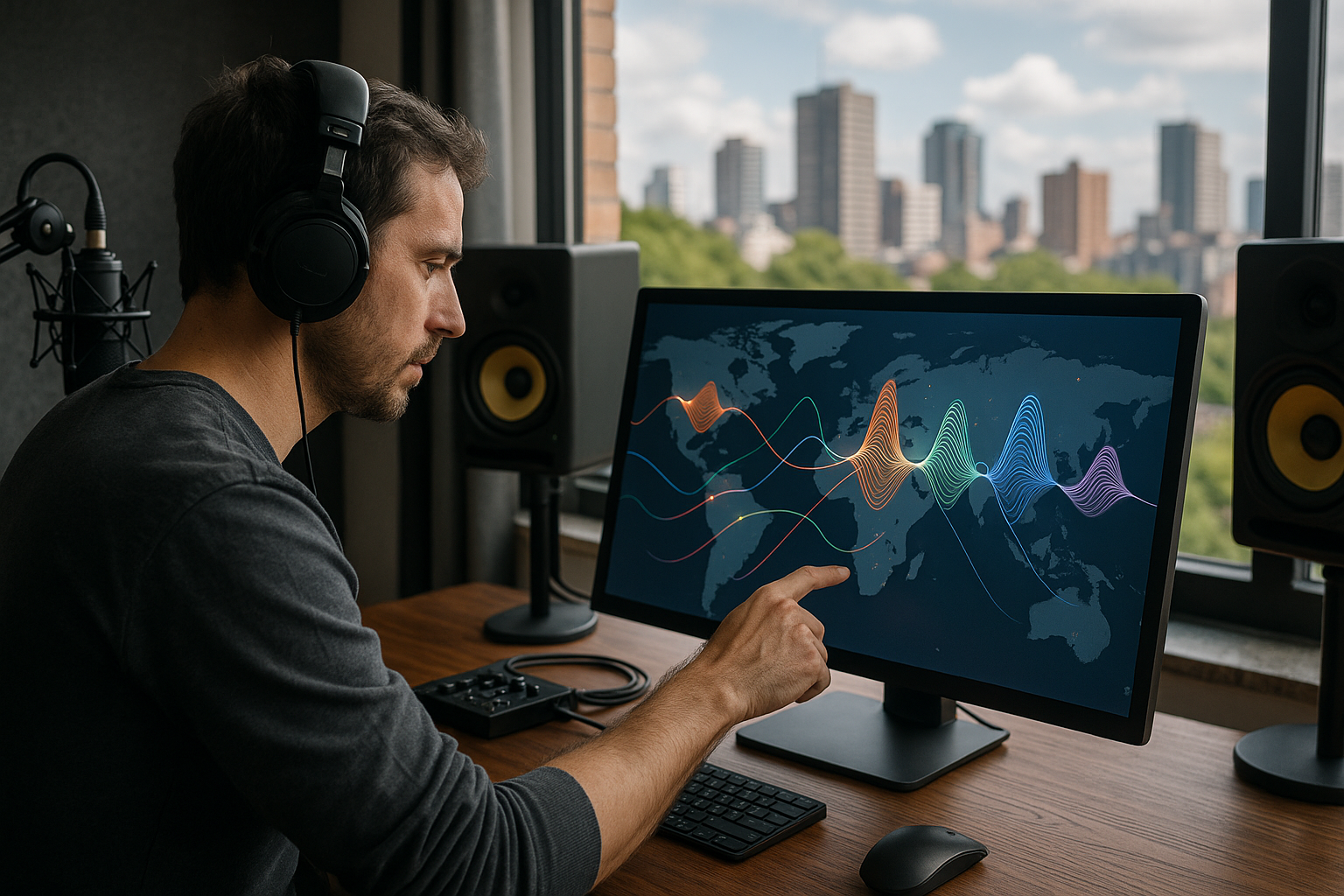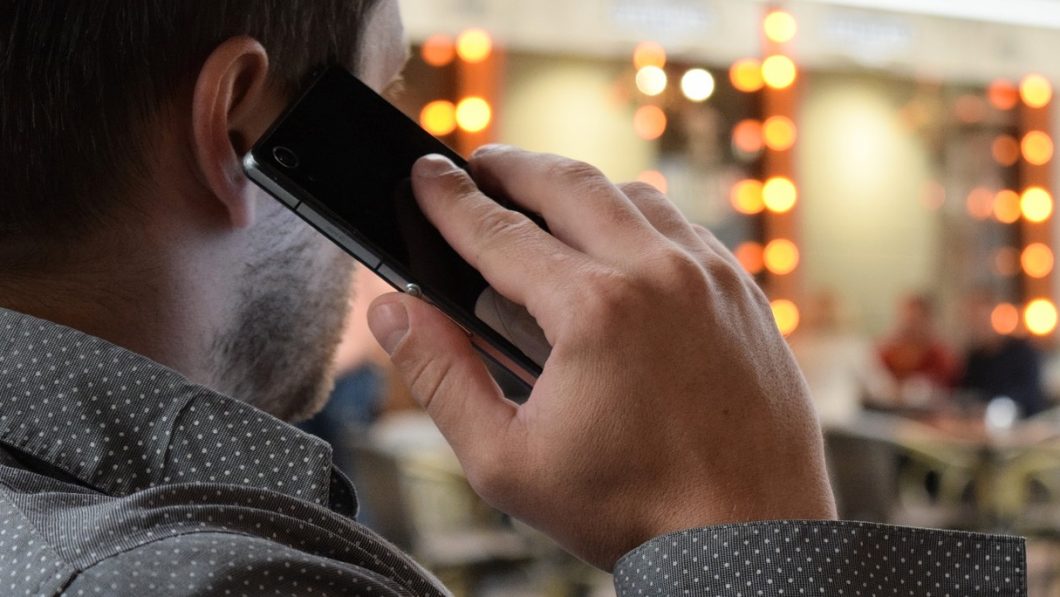Imagine stepping into a bustling marketplace in Marrakech, where the air is filled with the rhythmic clatter of vendors setting up their stalls, the distant melody of a street musician’s lute, and the vibrant chatter of people from every corner of the world. 🎶 Now, picture yourself transported to a serene forest in Japan, where the gentle rustle of leaves and the melodic chirping of birds create an almost meditative soundscape. What if you could capture these moments not just in pictures or words, but through an intricate tapestry of sounds? Welcome to the enchanting realm of sound mapping.
In this digital age, where visual content often reigns supreme, there’s a transformative power in closing our eyes and letting sound paint the picture. Sound mapping is more than just an auditory experience; it’s a journey through sound that enriches our understanding of places, cultures, and moments in time. This immersive technique allows us to explore destinations through the auditory cues that define them, offering a fresh and innovative way to document and share travel experiences.
But what exactly is sound mapping, and why is it gaining traction among travelers and storytellers? At its core, sound mapping involves recording and analyzing the soundscapes of specific locations to create a rich, auditory representation of a place. This practice is akin to crafting a musical composition where each sound is a note contributing to the symphony of a location. It’s about capturing the essence of a place through its auditory signature, providing a new dimension to the traditional travelogue.
The appeal of sound mapping lies in its ability to evoke emotions and memories in ways that photos or videos sometimes cannot. Hearing the sound of waves crashing against the cliffs of Ireland’s rugged coastline or the echoing calls to prayer reverberating through Istanbul’s ancient streets can transport you back to those places instantly, even if you’ve never set foot there. 🌍 This emotional resonance is what makes sound mapping a powerful tool for travelers and storytellers alike.
Throughout this article, we will delve into the art and science of sound mapping, exploring its origins and evolution in the digital age. We’ll examine the technology and techniques behind capturing high-quality soundscapes, providing you with practical tips on how to start your own sound mapping journey. Moreover, we will highlight the creative possibilities that emerge when combining sound mapping with other media forms, such as video and virtual reality, to craft compelling narratives that engage and inspire audiences.
Sound mapping is not just a hobby; it’s a bridge connecting us to the cultural and environmental nuances of our world. It encourages a deeper level of listening and awareness, prompting us to appreciate the subtleties that often go unnoticed in our fast-paced lives. From the vibrant chaos of a city square to the tranquil solitude of a hidden glen, sound mapping invites us to pause and truly listen to the world around us.
As we journey through this article, we’ll hear from pioneers in the field who are leveraging sound mapping to drive social change and environmental awareness. These innovators are using soundscapes to tell stories that matter, highlighting issues such as urban noise pollution and the impact of human activity on natural environments. Their work demonstrates how sound mapping can be a powerful catalyst for change, fostering a greater understanding of our interconnected world.
So, whether you’re a seasoned traveler looking to add a new dimension to your travelogues, a storyteller seeking fresh inspiration, or simply a curious listener eager to explore the world through sound, this guide to sound mapping is for you. 🎧 Prepare to embark on a sonic adventure that will transform the way you experience and share your journeys, opening your ears to the magic that lies within every corner of our planet.
Ready to unleash the magic of travelogues with sound mapping? Let’s dive in and discover how to capture the world’s most captivating soundscapes, turning ordinary trips into extraordinary auditory journeys. Your adventure through sound begins now!
# Journey Through Sound: Unleashing the Magic of Travelogues with Sound Mapping
Travelogues have long captivated audiences with their vivid descriptions and visual depictions of distant places, but there’s an emerging trend that adds an immersive layer to these narratives: sound mapping. This approach not only enhances the travel experience but also offers a unique perspective on how we can engage with new environments. Join us as we explore the fascinating world of sound mapping in travelogues, examining its potential to transform our auditory journey.
## The Rise of Sound Mapping in Travelogues
Sound mapping involves capturing and integrating ambient sounds from specific locations to provide a richer sensory experience. By incorporating these auditory elements, travelogues become more than just visual and textual narratives—they transform into multi-sensory journeys that can transport audiences to the heart of a destination.
### The Evolution of Travel Narratives
For centuries, travelogues have served as a bridge between explorers and armchair travelers, sharing stories of exotic locations and cultural experiences. Traditional travel narratives relied heavily on descriptive language and visual imagery to convey the essence of a place. However, as technology has evolved, so have the tools available to storytellers. Sound mapping is one such innovation, offering a new dimension to these narratives by capturing the unique auditory landscapes of each location.
### The Role of Technology in Sound Mapping
The rise of portable recording devices and advanced audio editing software has made it easier than ever to capture and integrate soundscapes into travelogues. High-quality microphones and handheld recorders allow creators to gather authentic sounds from bustling city streets, tranquil natural environments, and everything in between. Once recorded, these sounds can be meticulously edited and synchronized with visuals to create a cohesive and immersive experience for the audience.
### A New Way to Experience Travel
Sound mapping allows audiences to engage with travelogues on a deeper level. Instead of merely reading about or watching scenes from a destination, listeners can hear the distinct sounds that define each location. From the melodic calls of exotic birds to the rhythmic clatter of a train, these auditory cues help paint a more comprehensive picture of the environment and culture. For instance, the (https://www.youtube.com/watch?v=dQw4w9WgXcQ) offers insights into the practical application of sound mapping.
## Unlocking the Potential of Sound in Storytelling
The incorporation of sound mapping in travelogues is not just about adding ambiance; it can fundamentally alter the way stories are told and received. Through this method, storytellers can highlight underrepresented aspects of cultures, emphasize emotional beats, and offer new insights into the places they cover.
### Emphasizing Cultural Nuances
Sound mapping can reveal the subtle cultural nuances of a destination that might otherwise go unnoticed. For instance, the sound of traditional music played on local instruments or the cadence of a native language can convey a sense of place that visuals alone cannot. By highlighting these auditory elements, travelogues can foster a deeper understanding and appreciation of the cultural heritage and daily life of a region.
### Emotional Resonance Through Sound
Auditory elements have a profound impact on our emotions. A well-placed sound can evoke nostalgia, excitement, or tranquility, enhancing the emotional depth of a narrative. By carefully curating the soundscape of a travelogue, creators can guide the emotional journey of the audience, making the experience more engaging and memorable.
### Innovative Storytelling Techniques
Sound mapping opens up new possibilities for creative storytelling. By integrating sounds from different locations, storytellers can create audio-based narratives that transport listeners to various settings without the need for visual cues. This approach not only challenges traditional storytelling formats but also provides opportunities for experimentation and innovation.
## The Art and Science of Capturing Sounds
To effectively incorporate sound mapping into travelogues, creators must master the art and science of capturing high-quality audio. This involves understanding the technical aspects of sound recording as well as developing a keen ear for identifying and selecting meaningful sounds.
### Selecting the Right Equipment
Choosing the right equipment is crucial for capturing high-quality audio. While professional-grade microphones and recorders can provide exceptional results, there are also more affordable options that offer impressive performance. The key is to select equipment that suits the specific needs and constraints of the project, whether it involves recording in challenging environments or capturing subtle sounds.
- Handheld recorders: Portable and versatile, ideal for field recordings.
- Shotgun microphones: Excellent for isolating specific sounds in noisy environments.
- Omnidirectional microphones: Capture ambient sounds from all directions.
### Techniques for Capturing Authentic Sounds
Capturing authentic sounds requires more than just technical knowledge; it also involves a deep understanding of the environment and a sensitivity to the nuances of each location. Field recording techniques such as strategic microphone placement, attentive listening, and patience are essential for capturing the essence of a soundscape. Additionally, being respectful and unobtrusive while recording can lead to more genuine and natural results.
### Balancing Soundscapes with Narrative
Once sounds are captured, they must be carefully edited and integrated into the travelogue. This process involves selecting the most impactful sounds, balancing audio levels, and synchronizing them with visuals to create a cohesive narrative. Effective sound editing can enhance the storytelling experience, guiding the audience’s attention and emotions throughout the journey.
## Bringing Stories to Life: Case Studies of Sound Mapping
To illustrate the transformative power of sound mapping in travelogues, let’s explore some real-world examples where this technique has been successfully implemented, highlighting the diverse ways it can be used to enrich storytelling.
### Urban Soundscapes: The Pulse of the City
In bustling urban environments, sound mapping can capture the dynamic energy and rhythm of city life. For example, a travelogue exploring New York City might incorporate sounds of honking taxis, street musicians, and the chatter of passersby to convey the city’s vibrant atmosphere. These auditory elements not only provide a sense of place but also immerse the audience in the unique character of the city.
### Natural Soundscapes: The Serenity of Nature
In contrast to urban settings, natural soundscapes offer a different auditory experience. A travelogue set in the Amazon rainforest might feature the sounds of rustling leaves, flowing water, and the calls of wildlife to evoke a sense of tranquility and wonder. By focusing on the natural sounds of a location, storytellers can transport audiences to serene and awe-inspiring environments.
### Cultural Soundscapes: The Heartbeat of Tradition
Sound mapping can also highlight the cultural heritage of a destination. A travelogue exploring the traditions of Japan might include sounds of traditional festivals, the clinking of tea cups during a tea ceremony, or the chanting of monks in a temple. These auditory elements provide insight into the customs and rituals that define a culture, enriching the narrative with depth and authenticity.
## The Future of Travelogues with Sound Mapping
As technology continues to evolve, the potential applications of sound mapping in travelogues are boundless. This innovative approach not only enhances the way we experience stories but also offers exciting opportunities for exploration and discovery.
### Virtual Reality and Immersive Experiences
The integration of sound mapping with virtual reality (VR) technology presents new possibilities for creating fully immersive travel experiences. By combining 360-degree visuals with spatial audio, creators can transport audiences to destinations around the world, allowing them to explore and interact with the environment in real time. This convergence of technologies has the potential to revolutionize the way we experience travelogues, offering a truly immersive and interactive experience.
### Collaborative Storytelling
Sound mapping also opens up opportunities for collaborative storytelling. By encouraging audiences to contribute their own sound recordings, creators can build a diverse and comprehensive auditory archive of a destination. This collaborative approach not only enriches the narrative but also fosters a sense of community and shared exploration among participants.
### Expanding the Reach of Sound Mapping
As sound mapping gains popularity, its applications are expanding beyond traditional travelogues. From podcasts and documentaries to interactive installations and educational programs, this technique is being used to engage audiences in a variety of contexts. As creators continue to experiment with sound mapping, new and innovative uses are likely to emerge, further enriching the world of storytelling.
—
Throughout this exploration of sound mapping in travelogues, we’ve uncovered the myriad ways this technique can transform our auditory journey. By integrating authentic sounds into storytelling, creators can offer audiences a richer, more immersive experience that transcends traditional narratives. As you embark on your own sonic adventure, consider the power of sound to enhance your travel stories and transport your audience to new and exciting destinations. 🌍🎧

Conclusion
Conclusion
As we reach the end of our exploration into the world of sound mapping, it’s time to recapitulate the remarkable journey we’ve undertaken through this article. From the intricate relationship between soundscapes and travelogues to the innovative ways sound mapping can transform travel experiences, we’ve covered substantial ground. The essence of sound mapping lies in its ability to encapsulate the soul of a place, offering an auditory dimension to storytelling that is both immersive and evocative.
Throughout the article, we have seen how sound mapping enhances travelogues by providing a sensory-rich experience. It allows travelers to capture and convey the unique auditory essence of their journeys, transcending mere visuals. This approach not only enriches personal memories but also offers audiences a more engaging and multidimensional view of distant lands. 🌍
One of the key highlights of sound mapping is its potential to bridge cultural gaps and foster a deeper understanding of diverse environments. By immersing oneself in the ambient sounds of a locale, listeners can gain insights into the cultural nuances and natural beauty that define each destination. This auditory exploration goes beyond language barriers, connecting people through the universal language of sound.
Moreover, sound mapping empowers individuals to become storytellers in their own right. With accessible technology, anyone can create and share sound maps, democratizing the art of storytelling. This not only enhances personal creativity but also enriches the global repository of cultural narratives. The collaborative nature of sound mapping encourages sharing and dialogue, bringing communities together through shared experiences. 🎧
The impact of sound mapping extends beyond individual exploration; it holds significant potential for educational and conservation purposes. By documenting and preserving the auditory landscapes of endangered environments, sound maps serve as valuable tools for raising awareness about ecological issues. They encourage a sense of stewardship and responsibility towards preserving the world’s auditory heritage for future generations.
As we conclude this discussion, it is crucial to emphasize the importance of embracing the magic of sound mapping in our travelogues. It is a reminder that every journey is composed of countless sounds that tell stories waiting to be heard. We invite you, dear reader, to embark on your own sound mapping adventures. Whether you’re a seasoned traveler or an armchair explorer, there’s a world of sound waiting to be discovered and shared. 🗺️
We encourage you to comment below and share your thoughts on how sound mapping has enhanced your travel experiences. Have you captured any unique soundscapes that left a lasting impression? How do you envision incorporating sound mapping into your future journeys? Your insights and stories could inspire others to embark on their own auditory explorations.
Feel free to share this article with fellow travel enthusiasts and sound aficionados. Together, let’s spread the word about the transformative power of sound mapping and encourage others to listen closely to the world around them. As we tune into the symphony of sounds that shape our planet, we cultivate a deeper appreciation for the rich tapestry of life that surrounds us.
Thank you for joining us on this auditory journey. May your future travels be filled with the harmonious echoes of adventure and discovery. Safe travels and happy sound mapping! 🎵
For further reading and inspiration on sound mapping, you can explore these resources:
Toni Santos is a sensory storyteller and soundscape artisan whose work explores the forgotten language of the Earth through acoustic ecology storytelling. With a deep reverence for the natural world’s sonic textures, Toni crafts narratives that awaken our ears to the subtle music of forests, winds, waters, and wild silence.
His creative journey is rooted in a desire to preserve and interpret the acoustic heritage of environments, both ancient and fragile. From the echo of birdsong in a disappearing jungle to the resonance of stones in sacred landscapes, Toni’s stories reflect the memory held in sound—often overlooked, yet deeply felt.
With a background in environmental aesthetics and sonic design, Toni blends field recordings, visual symbolism, and poetic insight to create immersive experiences that honor the sonic soul of nature. His work does more than document; it invites listeners to re-tune themselves to the rhythms of life that still pulse beneath modern noise.
As the voice behind Vizovex, Toni shares sound-based studies, ambient narratives, and reflective content that help others reconnect with how sound shapes memory, meaning, and place.
His work is a tribute to:
The lost soundscapes of vanishing ecosystems
The role of natural acoustics in cultural and emotional memory
The healing potential of listening deeply to the world
Whether you’re an artist, an ecologist, or someone drawn to the quiet power of listening, Toni invites you into a space where every rustle, ripple, and resonance becomes a story—one note, one place, one heartbeat at a time.




